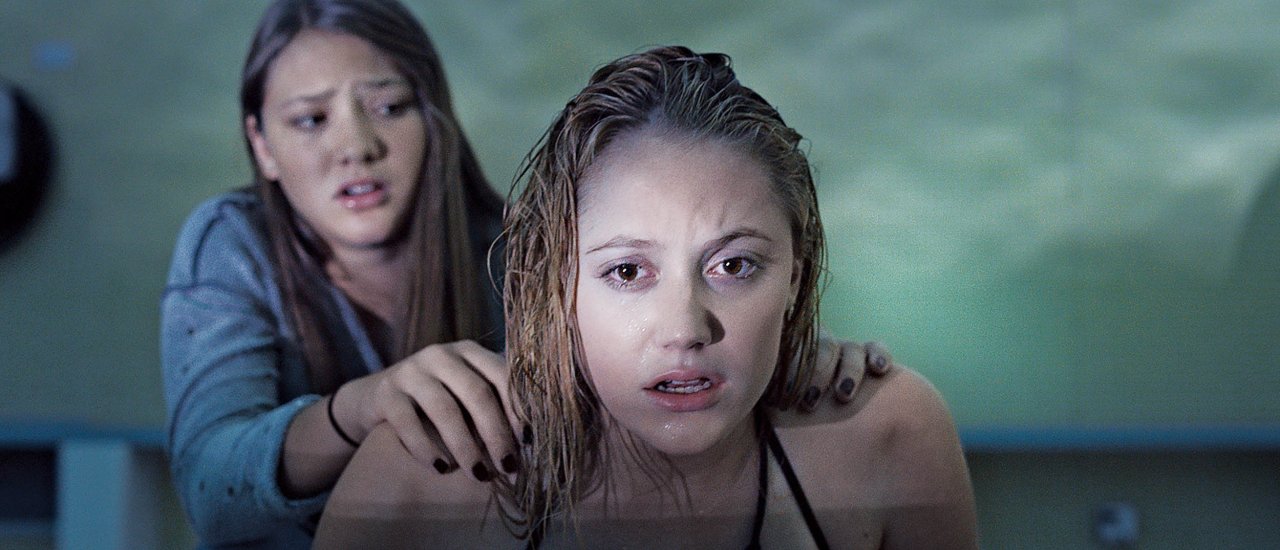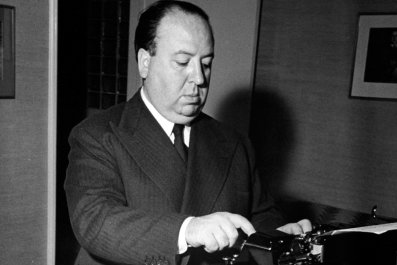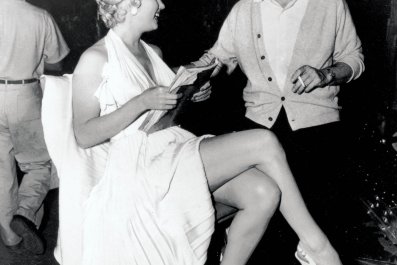Back in the '80s there was an urban legend of a man/woman who picks up a willing sex partner at a bar/club and takes him/her back to an apartment/hotel. They do the deed, and in the morning the pickup wakes to discover the easy lover has vanished. In the bathroom our protagonist discovers a message written in lipstick/shaving cream/blood on the mirror: "WELCOME TO THE WORLD OF AIDS."
That apocryphal tale tapped into the fears of anyone who came of age during the AIDS plague years. It's this vein that writer-director David Robert Mitchell drains with It Follows, the young filmmaker's second feature. An indie horror film shot over 28 days in Mitchell's hometown of Detroit, It Follows tells the story of Jay (Maika Monroe), a 19-year-old girl who sleeps with a boy she likes but awakens to discover that she's contracted a sexually transmitted monster—one that will continue to slowly stalk her with the aim of brutally rearranging her body parts. Unless, of course, she has sex with someone else and passes the monster to him. But if it happens to catch and kill her next sexual partner, it comes back for her, and so on. The film played to strong reviews at the Cannes and Toronto film festivals, and it will have midnight screenings at the Sundance Film Festival before a March 27 theatrical release.
"The basic idea of being followed by something that is slow but never stops is from a nightmare I had when I was a kid," says Mitchell. "I would see someone in the distance, and they would just be walking very slowly towards me, and I would turn to the people around me and point them out, and they wouldn't know what I was talking about. I immediately knew that this was a monster, something that was going to hurt me. And I would run away from it and wait, and then eventually it would come around the corner.… I could always get away from it, but what was horrible about it was that it just never stopped. It was always coming for me."
The unrelenting pursuer—think the Terminator, or Michael Myers or Pepe Le Pew—is the creepiest thing about It Follows. Mitchell wisely avoids the torture-porn and gore commonplace in modern horror and instead creates a dreamlike setting that references both John Carpenter and David Lynch, with a shifting, synthetic score that moves between melodic passages and controlled noise.
The suburban Detroit setting is also not something we're used to seeing on film, lending the movie an air of unfamiliarity. It's hard to put your finger on many of Mitchell's locations—even the decade. "There are references to things in the '70s and '80s. We were going for an outside-of-time feel to take it outside of our reality just enough." One character reads Dostoyevsky's The Idiot on an e-reader that looks like a birth control pillbox. "I just took a '60s shell compact and we just turned it into a cellphone," says Mitchell. "It physically looks like something from the '60s, but it has a modern element to it. It's just a little marker to show that this isn't quite our world."
This is where Mitchell's film differs from most other horror movies: If you took a few scenes out, it could in fact look like a magical coming of (sexual) age drama, which in a sense it is. Though Mitchell stopped having the stalking dream when he was young, when it took form as a film idea, the sexual element was added.
The sex monster, it should be noted, must obey some basic physical rules. It can't move through walls like a ghost, though it can break windows and climb through. And while it's invisible to anyone it isn't connected to, it can appear as anyone—a relative, schoolteacher, a weird naked man on a roof—to the person it's hunting. While it's inspired by zombies and pod people—things that don't necessarily race toward you but are still terrifying—it's one of the most original monsters of late, even if it comes as a grandmother in a nightgown walking toward you. "That's one of those fun things about a horror film," says Mitchell. "There are rules, but they have to be created by the people within the world, and those people have their own limitations. Like the things that Hugh [the one-night stand] tells Jay, that's his interpretation of what he figured out. The info comes from a highly suspect person."

Which made me wonder how frequently people intentionally deceive their sexual partners about their STD status. "As a general rule, we would say people ought to be honest and forthcoming with any potential sexual partners that they have a sexually transmitted disease," says Leslie Kantor, vice president of education for Planned Parenthood. "There are a couple of exceptions to that. Unfortunately, sometimes people feel that they're in a situation where there may be violence or some kind of abuse, and in that case, of course, then people should not disclose, because they could put themselves at risk."
Maybe Hugh's not such a bad guy after all; in a harrowing sequence, he straps Jay to a wheelchair in order to give her pointers on how to avoid the violence that's about to come her way.
After their encounter, Jay's reaction to her newfound STD status kicks off a twist on the "final girl" horror trope. In one of the most visual representations of innocence lost, Jay takes to a swing set in a wide-open field, where she can survey the distance for anyone walking toward her.
"Some people maybe read the film as trying to scare people away from sex and trying to make some sort of moral statement, but it's not that for me," says Mitchell. "To me, Jay is strong, and she's done nothing wrong. She slept with someone that she liked, and that's OK, and all these things that come from that are not punishment for sin. It's more about the reality of the world."
As for whether or not people believe that they can pass on an STD to someone else to cure themselves of it, it's not a commonly held notion here in America, but Kantor says the idea is not completely unheard-of. "There is some mythology in some areas of the world that having sex with a virgin will somehow cure HIV. There's some pretty scary implications from there, with people trying to have sex with younger teens and things like that."
"And you've never heard of any type of sexually transmitted monster?" I asked her.
"I have not."
And yet, monstrously terrible things can happen through sex. The fear that you might have a sexually transmitted disease looms in the same mental space in which a monster would loom. I acquired an STD in my freshman year of college, and it was one of the most horrifying experiences of my life. I never wanted to have sex with anyone again. For an 18-year-old boy, that's saying a lot.
"Even when I was a teenager thinking about it, I thought it could be really fun if it was something that could be shared in some way, almost like a game of tag," says Mitchell. "And then I thought that sex connects people physically and emotionally. And I sort of like the way that people have physical and emotional connections to people that they have slept with, and those things stay with us."
It Follows is really about mortality and morality, because you can escape the monster by giving It to someone else (at least temporarily). This would cause all kinds of interpersonal problems with real-world STDs. If I could have been free of my own affliction by simply bedding someone else, would I have? I asked Kantor about the infected-stranger urban legend.
"Most people are very responsible these days when it comes to their sexual lives and taking measures to prevent STDs," she says. "As an example, 80 percent of young men use a condom now the first time they have sex. That's really become a norm. This is not happening in a widespread way. There are a lot of STDs out there, but most of them are out there not because people are trying to give them to someone else but because they don't know they have them.
"It's true that people have sex for a lot of different reasons," Kantor continues. "While it sounds like a simple point, it's actually a pretty profound point. It runs the gamut, from wanting to connect deeply with someone to raging hormones."
Which, of course, brings us back to Dostoyevsky. "We aren't here forever," says Mitchell, speaking of the reference to the great Russian novelist. "And one of the ways that we can keep our fear of death at bay is through sex and through love. These are ways in which we can find a way to be OK with the fact that our lives are limited. And it's something that these characters are maybe just starting to become aware of, that it's something we all live with."































